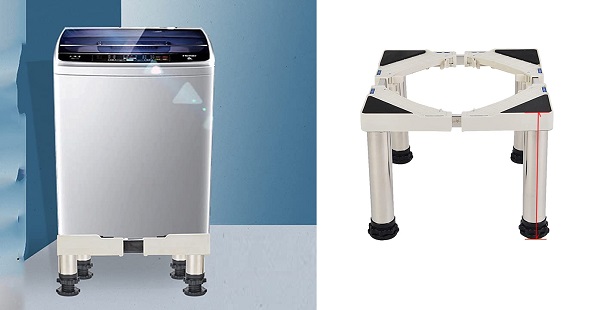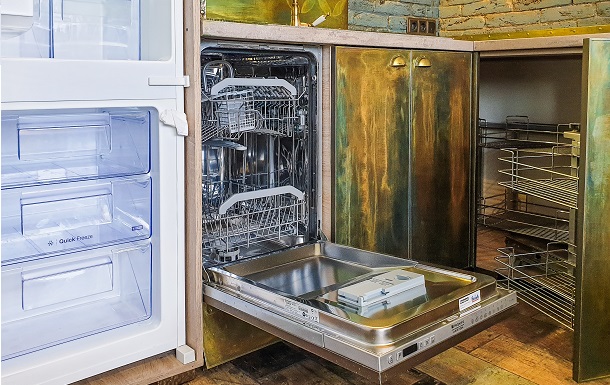If you have purchased a new dishwasher, you may be upset to discover that it doesn’t look exactly like the previous one. In other words, there is a gap between the dishwasher and countertop that looks so…unnecessary.
How to fix that? Is this dishwasher the wrong size?
Whichever the reason is, now you need to know how to fill that annoying gap so keep reading!
IN THIS ARTICLE:
Why Gap Happens?
Whether you are finalizing a kitchen installation or simply replacing a dishwasher it must look like it belongs there. Because the size of cabinets and dishwashers can vary, filling the gaps between the dishwasher and the cabinetry, gives you the finished look you want.


Are Dishwasher Sizes Standard?
Well, dishwashers might not all be exactly the same size, but they follow a rough standard. This ensures that most dishwashers fit within the same opening. As a result, your new dishwasher will probably fit into the same opening as your old one.
The typical rough opening for a dishwasher is 24 inches wide, 24 inches deep and 34-36 inches high. A compact dishwasher has the same depth and height rough opening measurements. But the width is 18 inches. On the other hand, an oversized dishwasher requires the same depth and height, but its width is 30-42 inches.
Filing The Gap – Two Methods
The easiest way to fill the gap between the dishwasher and the countertop is to elevate the dishwasher. There are two simple ways to do it.
- Raise the dishwasher’s adjustable feet – This method is pretty obvious and it’s the simplest solution, even some people may not realize they can just raise the dishwasher.
- Elevate the dishwasher with shims and cover with a toe plate (if necessary) – Use this method if the dishwasher is already as high as it can go.
1. Method – Raise The Dishwasher
Most dishwashers have adjustable feet and this makes it easier to fit it snugly into a pre-cut rough opening. Check if you can raise the dishwasher a bit higher and eliminate the gap. If the gap is too big, you can buy an adjustable dishwasher stand.
Usually, the door of the dishwasher stands a bit higher than the rest of the machine. So you can leave a small gap between the dishwasher and the countertop. Thanks to the door, you won’t have to see it.


2. Method – Elevate The Dishwasher With Shims
If the dishwasher is already as high as it can be, then you’ll need to help it get a bit higher. So, measure the gap first and figure out how high you need to elevate the dishwasher. Then you can install a 2×4 piece of plywood on either side (or another thinner piece of wood).
Get two pieces of wood that are long enough to lift two legs at a time. First, put one under both legs on the right side. Then, put the other plank of wood under both legs on the left side. This is crucial because it ensures the greatest level of stability.


Use a leveling tool to ensure the dishwasher is stable and square. Usually, there is a metal plate in the front of the dishwasher, and it may extend down, making it easy to cover your wood extension.
Important Note!
- Don’t raise your dishwasher too high. A slight gap is necessary to allow airflow. Plus, you may block the dishwasher door from opening. Only raise it to hide a large gap.
Why The Small Gap Is Necessary?
The space between the dishwasher and countertop is normally determined by the manufacturer. So it is best to follow the manufacturer’s recommendations for the best results. The gap is necessary because dishwashers create a lot of heat and humidity. It can damage the counters to be exposed to these elements too closely.
Most manufacturers recommend a gap of 1/2-3/4 of an inch.
How The Small Gap Still Can Make Issues?
Although the small gap is necessary, it is also an open invitation for the accumulation of dust around your dishwasher. And removing a dishwasher to clean its partially enclosed space, can be a bit tricky. Moreover, if your kitchen is made up of wooden cabinetry, steam from dishwasher can damage your cabinetry.


What Goes Around a Dishwasher?
Dishwashers usually come with an insulation blanket. You might think it’s just a packaging material and want to throw it away. But it is an important piece that goes around the dishwasher.
The insulation blanket keeps the heat from the dishwasher. This protects your nearby surfaces from heat damage. It also reduces the noise since it absorbs sounds.
If you throw these packaging away, you can use ceramic fiber insulation – if offers the best protection against vibration, heat and sounds.
How To Solve Other Gaps – Cabinet And Wall
Now when you know how to handle the gap between dishwasher and countertop, you may wonder should there be a gap between dishwasher and cabinet? And how close can dishwasher be to the wall?
How Much Space Should Be Between Dishwasher And Kitchen Cabinet?
Most manufacturers recommend a minimum of 27 inches (or more) between the edge of the dishwasher door when opened and the facing cabinets. Also, be sure to allow at least two inches between the dishwasher and the other kitchen cabinets.


Can You Put Dishwasher Next To Wall?
There should be space between them. So, the dishwasher needs to have at least 2 feet of space from the wall. The machine can get hot while it’s running and it can emit moisture. If you have your dishwasher too close to the wall, it will quickly result in mold and mildew building up.
Should Flooring Go Under The Dishwasher?
Well, yes, flooring should be right under the dishwasher. The floor must be under the dishwasher because the countertop can’t fully contain the weight of the dishwasher.
The Dishwasher Should Be Installed Before Countertop?
Countertops are typically installed after floorings, cabinets and appliances. All appliances including ranges, refrigerators, dishwashers and microwaves need to be in place prior to the countertop installation process.
To Wrap It Up
Dishwashers are an essential appliance in the modern home kitchen for providing peace of mind with continually sanitized dishes stocked in your cabinets. Ultimately, the goal is to lift the dishwasher so that you don’t see a large gap between it and the countertop.


















Leave a Reply